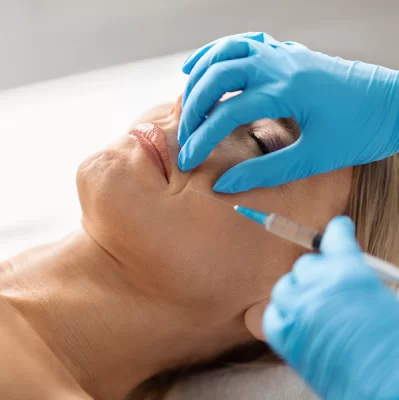Smile lines around the mouth
- What are wrinkles around the mouth and what accelerates their formation?
- What are the types of expression lines around the mouth?
- How to prevent wrinkles around the mouth through skincare and healthy habits?
- Which cosmetic procedures effectively remove wrinkles around the mouth?
- How do hyaluronic acid and tissue stimulators fill deep wrinkles?
- How does botulinum toxin and lasers eliminate smoker's wrinkles?
Lines around the mouth, often referred to as smile lines, are a natural result of the intense activity of the orbicularis oris muscle. Although they are associated with aging, they can appear surprisingly early, sometimes as early as 25 years of age. The main causes of worsening skin condition around the mouth are:
- decreased production of collagen and elastin, which reduces skin elasticity,
- photoaging - UV rays damage structural fibers,
- smoking - a significant catalyst for skin aging,
- frequent engagement of facial muscles (e.g. when drinking through a straw),
- bad habits, such as chewing gum or pouting,
- genetic predispositions.
The area around the mouth is particularly prone to the formation of expression wrinkles. The most common are the so-called smoker's lines, also known as "barcode lines". These are small, vertical lines above the upper lip, resulting from the intense work of the orbicularis oris muscle.
Another type of wrinkles around the mouth are marionette lines - deep grooves running vertically from the corners of the mouth to the chin, often giving the face a sullen expression.
It is also worth mentioning the nasolabial folds. These distinct indentations run from the sides of the nose to the corners of the mouth and deepen due to the effects of gravity and natural loss of skin volume.
Effective anti-wrinkle prevention requires a combination of proper skincare and eliminating habits that accelerate skin aging. The foundation is daily skin protection against photoaging. To achieve this, use a sunscreen with SPF 50+. Additionally, incorporate into your skincare routine products rich in powerful antioxidants that support cell renewal. Key ingredients include retinol, vitamin C, peptides, and niacinamide. Also essential is intensive moisturizing and regular, gentle exfoliation.
Complementary to anti-wrinkle care are: regular facial massage, exercises for mouth muscles, and adequate hydration of the body. The most crucial element in fighting wrinkles, however, is eliminating harmful mimic habits that lead to so-called smoker's lines. To reduce the formation of wrinkles, quit smoking, avoid drinking through a straw, and chewing gum.
To effectively reduce deep-set wrinkles around the mouth, aesthetic medicine utilizes various methods. The selection of these methods is always individualized and depends on the depth and character of the wrinkles.
The basis of the therapy consists of injectable treatments. Hyaluronic acid (HA) fills in deep hollows and restores lost volume to the skin, while botulinum toxin precisely smoothens out expression lines.
Advanced technologies and supportive therapies provide intensive stimulation of collagen production and regenerative processes, including:
- laser therapy,
- micro-needle radiofrequency (RF),
- microneedling,
- needle mesotherapy,
- platelet-rich plasma (PRP) therapy,
- specialized tissue stimulators.
Improvement in skin tension can also be achieved with lifting threads. The therapy is complemented by chemical peels and lipofilling, which is the grafting of one's own fat.
Hyaluronic acid (HA) is the most commonly chosen filler. It acts as a natural implant, instantly reducing deep grooves, such as marionette lines or nasolabial folds. Mechanically pushes wrinkles from the inside, replenishing lost skin volume, resulting in immediately smoothed and deeply moisturized skin.
Tissue biostimulators, on the other hand, act at a cellular level. Their key task is not only to fill wrinkles but above all to intensely stimulate fibroblasts to produce new collagen. Calcium hydroxyapatite initiates the natural rebuilding of the skin. Although the results of tissue stimulators are gradual, they last a long time, leading to natural skin densification and firmness.
Wrinkles above the upper lip, known as smoker's lines or barcode lines, respond well to botulinum toxin. Precise botox relaxes the orbicularis oris muscle, effectively limiting excessive facial expressions. This reduces the severity of facial movements, such as the popular "duck face", which effectively slows down the deepening of wrinkles.
However, when the issue is deep and persistent, thorough skin regeneration is necessary. In such cases, laser therapy is used. Fractional laser therapy intensely stimulates the production of key proteins: collagen and elastin. As a result, the skin thickens and smoothes, leading to a lasting reduction in even stubborn changes.
